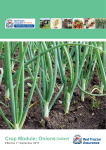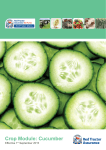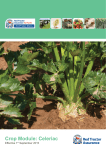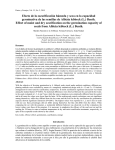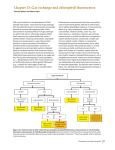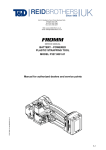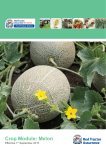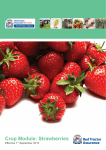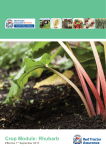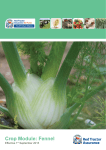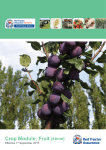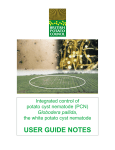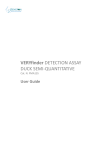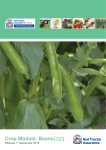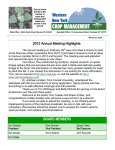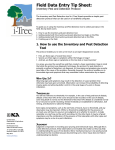Download Courgette. Marrow, Squash and Pumpkin 2015
Transcript
Marrow, Crop Module: Courgette, Squash and Pumpkin Effective 1st September 2015 Welcome T his crop specific module for courgette, marrow, squash and pumpkin has been written to complement and avoid duplicating the generic principles of the Red Tractor Farm Assurance Fresh Produce Scheme standards. It is advisable to read the Red Tractor Farm Assurance Fresh Produce standards before reading this crop specific module. This module is designed to stimulate thought in the mind of the reader. It contains crop specific guidance and standards, where applicable, in addition to the requirements stated in the generic Fresh Produce standards. Within this module the important requirements outlined in the crop specific standards section will be verified during the Red Tractor Farm Assurance assessment and compliance will form a part of the certification/approval decision. Disclaimer and trade mark acknowledgement Although every effort has been made to ensure accuracy, Assured Food Standards does not accept any responsibility for errors and omissions. Trade names are only used in this module where use of that specific product is essential. All such products are annotated® and all trademark rights are hereby acknowledged. General Introduction Following a systematic approach will help growers identify and manage the risks involved in crop production. This module is based on a typical crop production process and food safety, health & safety, environmental and quality hazards are identified. Appropriate controls may then be established to minimise risk. Food safety and health & safety issues always take precedent over quality and environmental controls. The layout of this module follows the same structure as that used in the Red Tractor Farm Assurance Fresh Produce Standards. The content of the module is reviewed prior to the issue of updated editions. The review process considers both new developments and all relevant technology which has emerged since the last review was completed and which have been found to be both workable by the grower and beneficial to the environment. The aim is to transfer such information and technologies to growers. Acknowledgements Red Tractor Farm Assurance Fresh Produce gratefully acknowledges the contribution of all consultees in the preparation of this protocol, particularly Neil Cairns of Barfoots. Notes: Pesticide Information The Red Tractor Fresh Produce team has been working with Fera to provide tailored access to the LIAISON database for all Red Tractor Fresh Produce members. This system allows individual growers access to all information for plant protection products approved for use under the Red Tractor Fresh Produce Scheme. LIAISON can be accessed under the Produce tab via the “Checkers and Services” page where you will also find a user manual. Searches will be filtered specifically for the crops for which you are registered. Once you have logged onto the site and clicked on the LIAISON hyperlink you will be directed to the LIAISON home screen. You will need a username and password and these will be sent once you have registered: http://assurance.redtractor.org.uk/rtassurance/ services/Registration/members.eb . 1 Red Tractor Assurance for Farms – Crop-specific Module: Courgette, Marrow, Squash and Pumpkin © Assured Food Standards 2015 Content Contents ADDITIONAL REQUIREMENTS AGAINST CURRENT STANDARDS 02 CROP SPECIFIC STANDARDS02 CHOICE OF VARIETY OR ROOTSTOCK AND PLANT HEALTH CERTIFICATION 03 SITE AND SOIL MANAGEMENT 03 ENVIRONMENTAL PROTECTION AND CONTAMINATION CONTROL05 PEST, DISEASE AND WEED CONTROL 06 NUTRITION 10 IRRIGATION10 HARVEST AND STORAGE 10 RESIDUES AND CONTAMINANTS 10 APPENDIX 1: TYPICAL APPLICATION RATES FOR NUTRIENTS 11 ADDITIONAL REQUIREMENTS AGAINST CURRENT STANDARDS None for this crop module CROP SPECIFIC STANDARDS None for this crop module Red Tractor Assurance for Farms – Crop-specific Module: Courgette, Marrow, Squash and Pumpkin © Assured Food Standards 2015 2 GUIDANCE CHOICE OF VARIETY OR ROOTSTOCK AND PLANT HEALTH CERTIFICATION BACKGROUND This protocol covers the field production of marrows, courgettes, squashes and pumpkins. Although it is technically possible, neither melons nor cucumbers are usually grown commercially in UK ‘outdoor’ situations. To understand where each product fits into the overall family of Cucurbitaceae, it is important to look botanically at each product and from where its name was derived. Marrow is the English word for the Italian “zucca” and the French “courge”. The English language has taken the French word “courge”, combined it grammatically with the French for small or diminutive (“ette”) to produce “Courgette” meaning small marrow. The American language has taken the Italian derivative to produce zucchini, which is now the American word for courgette and the Italian for marrow. Courgettes are, therefore, classed as small marrows. Squash is the American Indian term covering most summer (fresh) and winter (stored) cucurbits. Summer cucurbits may be broken down into marrows and courgettes. Gem squashes also fit into this category. Winter squashes are essentially storage squashes grown to full maturity, usually picked after the skin has set when the plant is usually senescing or has already senesced. A pumpkin is a winter storage squash. If cooked correctly, the skins of pumpkins and all squashes can be edible. Botanically, summer squashes are varieties of Cucurbita pepo. Winter squashes may be Cucurbita moschata, C. maxima or C. pepo. Pumpkins are either C. pepo or C. mixta. The whole group may be classified into two main types: Summer cucurbits are broken down into non-storage squashes such as marrows and courgettes. Gem squash can also fit into this category. Winter squashes are, essentially, storage squashes. These squashes are grown to full maturity, picked when the skin is set and when the plant is usually senescing or has already senesced. The storage squashes may be sub-divided into shortterm storage, where the skins are ‘semi-set’ and long term squashes (winter squashes) where the skins are hard set. 3 SITE AND SOIL MANAGEMENT SITE SELECTION Site selection depends greatly on market forces and the harvest timing of the crop. Early crops should be produced on south facing slopes, free of frost and with good wind protection. Cold, exposed sites are generally unsuitable for the production of the crop. Sites prone to flooding, high winds and frost, should be specifically avoided. SITE MANAGEMENT Soil management Ground preparation and early ‘pest’ prevention Ground preparation should, wherever possible, follow an overwintered frost-conditioned fallow. Whilst not always practical in very early planted crops, the early preparation of land not prone to slumping can lead to a heavy flush of weeds just prior to drilling and a well-timed, non-selective herbicide will control the majority of these emerging weed seedlings. This is a key husbandry technique approach in view of the extremely limited range of approved selective herbicides. If the crop is to be direct drilled, soils which tend to slump are not generally suitable for this ‘stale seedbed’ approach. The choice of equipment for ground preparation lies with the grower. Prevention of pest damage starts at this point as the early, cultural control of weeds prevents any chance of re-seeding. Cutworms (Agrotis spp), the caterpillars of several species of noctuid moths, are more likely to be a problem in fields where large-sized weed cover precedes last minute ground preparation. Cutworms graze at the base of the plant, severing the stem and the killing the plant. Prolonged weed cover, remaining uncultivated until immediately prior to planting or seeding, can also increase the risk of bean seed fly (Delia platura) attack. Attacked plants are usually unable to recover and quickly die. Slug monitoring should be carried out prior to drilling the crop. Slugs (Derocerus and Milax spp.) are not usually a problem in the cucurbit crop. However, in fields where slugs are an historical problem or where growers have no historical data, covered slug monitoring traps set prior to the drilling of the crop can indicate whether control measures are warranted prior to seeding, or whether an alternative field would be more suitable. Red Tractor Assurance for Farms – Crop-specific Module: Courgette, Marrow, Squash and Pumpkin © Assured Food Standards 2015 DRILLING AND TRANSPLANTING Drilling and planting dates Drilling and planting is generally determined by product group and the storage potential of the fruit produced. Courgettes and marrows are usually produced from sequential drillings and plantings through the season. The drilling and planting of storage squashes is usually determined by their growing cycles and length of time to maturity in the UK. Many of these storage squashes are planted/ drilled to produce fruit in a very short, noncyclical UK season. Cucurbits are very sensitive to frost. They can be planted under protection as early as the first week of April or direct drilled as late as the second week in July. They may be planted without protection from mid-May. Drilling/planting times depend on the cucurbit type being grown, the marketing of the crop and the ‘value’ of the fruit. Plant spacings are dependent upon cultural techniques and harvesting techniques and the type of crop being grown. Growers should decide upon the correct plant spacings to suit their own production. Standard plantings of summer squashes require approximately 10,000 plants per hectare. Non-storage cucurbits are usually planted as early as possible in the season and then sown/planted in succession sequentially into July or early August. Early plantings may be ‘forced’ by producing plants with heat under glass and planted into early seedbeds prepared with polythene mulches to promote soil temperatures and suppress weeds and covering with low polythene tunnels (cloches) to ensure frost protection and to elevate temperatures in early spring. As successive crops are planted drilled and the probability of frost diminishes, so these high inputs also diminish, culminating with crops being direct drilled into stale seedbeds without protection. Whilst storage cucurbits can be produced in the same way, it is more usual for plants to be raised for transplanting or direct drilled once the risk from of frost and other adverse weather conditions has passed. Propagating in modules or blocks is very straightforward. Module size and type is usually decided between the grower and the propagator and is normally linked to the planting technique. Seeds are usually hand-sown, taking 2½ to 3 weeks from seeding to seedling maturity. The seedlings are usually fed 2 weeks after sowing and ‘hardened’ off after 18 days. Agrochemical treatment of developing plants is rarely necessary. The use of biodegradable polythene mulches in cucurbit production is increasing growers should make every effort to re-cycle any non-biodegradable plastic, if this is not possible then it should be sent to a registered landfill site. Growers must not burn plastic waste (see DEFRA’s Code of Practice for Protection of Air). The cucurbit harvest season in the UK is approximately from the second week in June to the end of October. Most of non-storage cucurbits are harvested by the first week of October. Pollination The production of fruit on cucurbit plants is dependent on pollination but some plants, such as courgettes, can produce their fruit parthenogenetically. Fruit produced in this way is usually smaller, less abundant and will not contain viable seeds. Growers who wish to achieve full potential yields should actively encourage pollinators into the crop. Bees are the best of all potential pollinators and UK field-grown cucurbits are usually fully pollinated by wild bees. Very high and low temperatures can also affect pollen viability, resulting in poor pollination. If too much nitrogen is used (resulting in excessive vegetative growth) or plants were improperly spaced, bees may have difficulty locating the flowers. Growers, who expect to experience pollination problems, can elect to bring honeybee hives into the crop to increase the level of pollination. Growers can also elect to sow suitable wild flower mixtures around the boundaries of fields and within wheelings, to encourage wild bees into the vicinity of the crop. Growers should never apply agrochemicals at times when bees are actively foraging in the crop, even if the label does not state ‘Harmful to Bees’. Growers should always discuss the timings and use of agrochemicals with beekeepers prior to application. Site history Product type, geographical position, site selection and aspect, previous cropping, weed spectrum, soil type and tilth, and irrigation potential all play a critical part in the production of the crop. Compromising on any one of these points will almost certainly lead to unnecessary crop inputs and thus compromise the principles of ICM. One should also be mindful of historical virus issues where cucurbits have been previously grown, with particular emphasis on fields which are bordered by woodlands or extensive non-managed areas of vegetation. Red Tractor Assurance for Farms – Crop-specific Module: Courgette, Marrow, Squash and Pumpkin © Assured Food Standards 2015 4 Geographical location Cucurbit crops can be grown over the whole of the United Kingdom and can be direct drilled or planted as modules and blocks. Endemic weed spectrum This is a critical aspect in choosing the correct land for cropping because herbicide choice is extremely limited. Soil type and tilth The crops can be grown over a range of soil types. Heavier, moisture retentive soils are suitable for the planted crop but can impair emergence of the early drilled crop. Soils containing a proportion of stones may be suitable for crop establishment but Class 1 fruit production may be impossible due to physical damage as the crop trails. Soils where only a poorer tilth is achievable still have the potential to establish a good crop provided growers have the facility to raise plants in blocks or modules first. Rotation It is not advisable to follow a cucurbit crop with another cucurbit. Growers should aim to plan for at least a threeyear rotation in order to limit soil-borne disease infection from one cucurbit crop to the other. Cucurbits that follow tuber crops, such as potatoes, are likely to be severely at risk from the competition from volunteers from the tuber crop. ENVIRONMENTAL PROTECTION & CONTAMINATION CONTROL THE BASIC APPROACH TO CROP PROTECTION Integrated crop management 1. Pick the crop type required by the market. 2. Select the correct fields using the following criteria: - aspect, soil type, previous cropping, soil condition, protection, irrigation potential, weed spectrum. 3. Try to avoid drilling or planting in close proximity to wild flower and weed areas that may act as a reservoir for virus. Consider the physical separation of cucurbit plantings/drillings in order to limit disease spread between sequential crops. 4. Wherever possible, prepare seedbeds in advance to creating the opportunity to burn off weeds prior to planting or drilling to produce a stale seedbed. 5 5. Apply a proportion, if it is feasible to safely apply nutrition after crop emergence, or all of the nutrition in the seedbed. Take the advice of a FACTSqualified advisor. 6. On lands prone to slugs, set traps to evaluate slug populations. If populations are high aim to find another site. Failing this, apply baits in advance of drilling to minimise crop damage. 7. Where agronomically practical and financially acceptable choose physical barrier methods to suppress weeds and prevent aphid attacks on the developing crop. 8. Evaluate the need for residual herbicides, whilst bearing in mind the potential growth check to the crop due to phyto-toxic effect of herbicides. 9. Evaluate the advantages in planting the crop rather than drilling. Consider the recycling of polythene mulches and low tunnels. 10.Field inspections should be carried out to determine cutworm activity. Do not treat prophylactically. 11.In un-barriered crops, inspect plants regularly for aphid infestations and treat accordingly. 12.Remove mechanically, or by hand any remaining troublesome weeds. 13.Field inspections are carried out for virus/disease identification and any plants exhibiting symptoms of virus/disease are rogued out and burned where necessary. 14.Evaluate the bee activity in the crop. If necessary, bring in hives to supplement wild bee activity. 15.As the crop changes from vegetative to reproductive growth, and sometimes before in some very susceptible areas, use weather patterns to predict potential disease development times. Use these predictions, in addition to regular field inspections, to evaluate timings for main disease control. 16.Continue to make field inspections throughout the life of the crop. A critical time for aphid infestation, and thus virus infection, is when courgette crops are being harvested. Assess aphid numbers and the numbers of actively feeding predators then choose the most suitable form of control. Aim to preserve predators if your inspection indicates a satisfactory predator prey ratio. Treatment with a non predatorfriendly insecticide should be made only when bees are not foraging in the crop, i.e. late evening. Red Tractor Assurance for Farms – Crop-specific Module: Courgette, Marrow, Squash and Pumpkin © Assured Food Standards 2015 17.Viruses are transmitted in frequently harvested crops on harvesting knives. Twist the fruits from the plant and trim the stalks prior to packing, rather than cut straight from the plant. 18.Maintain crop hygiene during the harvesting period. 19.Ensure prompt crop removal after the last fruits have been removed. Desiccate crops infected with gummosis / scab and virus in order to prevent carryover in crop trash. Plant protection product choice APPROVED USES NOT INCLUDED ON THE PRODUCT LABEL In many circumstances, particularly for minor crops, product labels do not include all of the approved uses and growers wishing to check the approval notice of a particular product should note that this information is available using the LIAISON® search accessible via their RED TRACTOR Farm Assurance home page after logging in. A search on the ‘‘Extension of Authorisation’ page of LIAISON® by crop or product name should yield a results page. A click on the product name should link to a summary of the approval information. Near the bottom of the summary is the specific extension of authorisation number (e.g. 0246/09) and this link will open up a pdf of the current document giving details of the extension of use. PEST, DISEASE AND WEED CONTROL Pest control Agronomically, established plants are treated slightly differently depending on the method of production. Plants covered with low tunnels (cloches) need to be protected from wind, frost and general cold conditions, for as long as those conditions persist. These covers can be temporarily removed (drawn back) during favourable conditions and replaced if conditions deteriorate. When conditions become consistently favourable the tunnels are removed but the plants are then more readily susceptible to attack by parasites and virus vectors. Growers who covered their crop with floating mulch usually choose to keep their crop covered until flowering. However, the choice of mulch can be critical agronomically. Non-woven fleece covers can, if they remain intact, provide a complete barrier against any insect parasites that may infest the aerial parts of the crop obviating the need to apply an insecticide for the control of these pests. Plastic mulches have to be perforated so, although they have the potential to produce more heat units for the growing crop, they allow access to insect parasites and, therefore, cannot be relied on as part of an integrated control of pests. The removal of tunnels and floating mulches is at the discretion of the grower. Factors such as heat, moisture, weed levels, insect numbers, wind damage, and the chance of frost, should all be taken into account prior to removal. At the latest, crop covers should be removed by the time the flower opens to facilitate pollination. Insect pests can be categorised into those which attack and kill the plant and those which parasitise the plant, stunting its growth and, more importantly, spreading virus. Cutworm and bean seed fly As there are now no approved insecticides for either of these pests, it is essential to employ cultural control methods to reduce the risk of damage from these pests. Early cultural weed control can help to reduce the risk of both cutworm (Agrotis spp), and bean seed fly (Delia platura). Regular field monitoring should be undertaken to determine pest activity. Even though covers may completely protect the crop from attack, the adult stages of both pests can lay their eggs prior to cultivation and thus growers should inspect both protected and unprotected crops. The damage from bean seed fly is sporadic and localised. The most serious damage to cucurbits occurs on plants raised in peat blocks, soon after planting out. Plants will collapse completely, often within seven days of planting out. As the flies prefer to lay their eggs on freshly disturbed soil, planting or drilling into a stale seedbed, without the need for early hoeing may reduce the likelihood of attack. Cutworm control can be achieved culturally through suppression by heavy irrigation or periods of heavy rain. Aphids The main insect pests of the developing crop are aphids, the main species are the peach-potato aphid (Myzus persicae) and the melon & cotton aphid (Aphis gossypii). Whilst heavy aphid infestation can stunt the plant and delay maturity, their main role is as a vector for cucurbit viruses. Any aphid infestations, (certainly at all stages of the crop up until first production and in virus-prone areas, well into the production cycle and fruit development stage) should be viewed as potential virus transmitters and Red Tractor Assurance for Farms – Crop-specific Module: Courgette, Marrow, Squash and Pumpkin © Assured Food Standards 2015 6 should be treated. Therefore, growers are encouraged to carry out regular field inspections to determine the level of aphid incidence. Whenever virus infected plants are seen, growers should remove all the plant from the field and destroy completely by burning. Other pests There are a limited number of foliar-applied insecticides approved for cucurbits. Those natural predators, which help reduce aphid numbers, include hover flies, ladybirds, lacewings and parasitic wasps. The incidence of these predators should be determined prior to choosing the most suitable method of aphid control. Mites can be treated in all cucurbits biologically. Encouraging ladybird larvae and lacewings into crops will have a beneficial effect on mite control Foliar-applied aphicides If aphids are found, at any stage in the development of the crop, growers have to make an objective choice to control them. This action is very important in areas prone to CMV or ZYMV if transmission of these viruses is to be limited. There is a limited range of aphicides approved for use in cucurbit crops. Early aphid attack can be the most likely to cause premature crop death through early virus transmission. Wherever field inspections show good predator activity in marrows and courgettes, and certainly where bees are active in the crop, growers should elect to use products containing pirimicarb as both predators and pollinators are relatively unaffected by this active ingredient. In heavy infestations where the predator/pest ratio is greatly in favour of the pest, growers may wish to reduce the balance by an instant knockdown of aphids. Here, courgette and marrow growers have the option of using Thiacloprid based products. Growers also have the option of treating aphid infestations with fatty acid based products that have a zero harvest interval. Molluscs Slug monitoring is an important part of slug control. Baits, applied to a small area and then covered to prevent vertebrate animals eating any of the dead slugs, provide a good way of monitoring activity prior to drilling the crop. Depending on the numbers of slugs trapped, growers can take decisions ranging from no action, applying pellets prior to drilling (especially important in the mulched crop) or even choosing another site. The choice of active ingredient for the control of slugs in cucurbits is now limited to Metaldehyde, but there are a wide choice of products containing this active ingredient. Growers should elect to use those products that are formulated to provide good longevity. Control is usually only warranted at the seedling stage. 7 Another pest of cucurbits is two-spotted spider mite (Tetranychus urticae). This pest is only seen occasionally but can be very destructive in hot, dry conditions. Other insect pests include whitefly (family Aleyrodidae) and thrips (family Thripidae). Field scale production is rarely affected by the occurrence of these pests and thus treatment is rarely warranted but pumpkins can be plagued by whitefly which can be treated with ‘fatty acid’ based products. Pollen beetles occasionally infest the open flowers but do not appear to affect the plant or its production. Their presence can dissuade bees from the flowers, which can have a negative effect on pollination and hence shape on certain squash types. Biological control organisms Growers can elect to control spider mites by biological means. Growers of all cucurbits have the option to introduce the predatory mite Phytoseiulus persimilis. Field trials have shown good control of spider mites is achievable with Phytoseiulus. If regular field inspections give an early indication of a build-up, growers should contact distributors of this predator and discuss with their technical representatives the feasibility of biological control in this circumstance. If whitefly builds to excessive levels in pumpkins, growers have the opportunity to apply fatty acids to reduce pest levels. These products are less damaging to beneficial predatory and non-target insects. DISEASE CONTROL As the plant develops from seedling stage through its vegetative stages, it is rarely visibly plagued by disease. The symptoms of diseases generally become visible on the plant when it changes its growth habit from vegetative to reproductive. There are two main diseases of cucurbits, gummosis (Cladosporium cucumerinum) and powdery mildew (Erysiphe cichoracearum and Sphaerotheca fuliginea). Both of these diseases are linked to weather conditions and can, for the most part, be predicted. Gummosis Gummosis or Scab is a disease that develops rapidly in warm (17-21°C), wet weather conditions, and cool nights accelerate the symptoms. It spreads primarily from infected material and subsequently through wind blow and rain splash. The disease has the potential to Red Tractor Assurance for Farms – Crop-specific Module: Courgette, Marrow, Squash and Pumpkin © Assured Food Standards 2015 destroy all marketable yield within a very short space of time. Courgette crops are particularly vulnerable to the disease that first appears as a vague leaf symptom and then manifests itself on the developing fruits. The fruits firstly develop dark green spots on the surface which then sink into the flesh and begin to ‘weep’ a gummy substance. All infected fruit is unmarketable. Whilst courgette crops can suffer from this disease, it is often particularly noticeable in late season marrow crops and also pumpkin crops. With both crops, the scab often dries out and appears to ‘heal’, however in marrow crops, this is still unmarketable and with storage squashes and pumpkins, this scab can then breakdown to produce ‘rot spots’. An integrated disease prevention approach is the best approach for growers. Previous cropping has to be taken into account with at least a three-year rotation between crops. Crops exhibiting signs of infection should be identified as soon as possible and the positioning of later drillings should, wherever possible, be re-evaluated. Care should be taken to avoid the unnecessary transference of crop material to other cucurbit sites. ‘Waste’ fruit should be destroyed or dumped in areas well away from production sites. Infected crops should be desiccated in the field prior to cultivation to remove debris on which the disease can survive. Fungicides for gummosis control Currently there are: Powdery mildew Although gummosis has the potential to be a most devastating disease of courgettes, it is powdery mildew that invariably kills the cucurbit plant. This disease overwinters on weeds and its spores are carried long distances in the air. Normal UK summer temperatures and humidity favour the development of the disease. The disease will not, however, develop well in prolonged periods of heavy rain where the leaves remain continually wet. The disease quickly spreads over the surface of the leaves, acting primarily as a carbohydrate sink, diverting the photosynthates away from the developing fruits. Once the leaf is covered, it dies and the plant begins to defoliate. Once the disease is well established, the older leaves are lost faster than new ones are produced, so fruit development quickly ceases. In the case of storage squashes, fruits are set prematurely before the required size specification is met and often before the sugar levels have reached their desired potential. The harvested fruit is often, therefore, well below size and taste specification. Culturally, there is little a grower can do to prevent the onset of the disease. At present, it is not possible to fully control the disease, but regular field inspections can determine when the disease is first visible on the leaf and immediate fungicide treatment will certainly slow the rate of development of the disease on the plant Crops should be destroyed as soon as the grower has determined the last fruits have been harvested. Fungicides for powdery mildew control In order to ensure that the cucurbit crop remains in production for as long as possible, growers should make routine field inspections for early the signs of powdery mildew infection. Usually, by applying a suitable agrochemical at the first signs of the disease, growers can slow the rate of development of the mildew. This can achieve a potential two to three week extension to the life of the crop. Unfortunately, no matter how many times products are applied, the powdery mildew will gradually infect the whole plant. Growers should aim to contain the disease rather than continually apply fungicides in an effort to eradicate the disease. A programme of two to three well timed sprays, alternating active ingredients where possible and starting when the infection is first seen (normally just prior to fruit production), is the most sensible agronomic approach. There is a choice of products, depending on the crop. Courgette growers can use products containing either azoxystrobin, bupirimate or mepanipyrim. Marrow growers can use products containing either bupirimate or fenarimol. Squash and pumpkin growers are able to apply products containing fenarimol. There are now varieties of courgette on the market which show significant tolerance to powdery mildew. A commodity substance approval for potassium bicarbonate for the control of powdery mildew is also available. Commodity substances are chemicals which have a variety of non-pesticidal uses and also have minor uses as pesticides. Food grade potassium bicarbonate can be used to give effective control of powdery mildew. Virus diseases The main virus in the United Kingdom is cucumber mosaic virus (CMV). Since the end of the 1980’s the potentially more troublesome zucchini yellow mosaic virus (ZYMV) has become more prevalent in the UK. Both viruses are devastating to the plant and have the potential to firstly reduce yield, secondly to distort and drastically reduce marketability of the fruit and finally may even cause premature plant death. Sequentially cropped non-storage crops are primarily affected by yield loss and reduced marketability. Red Tractor Assurance for Farms – Crop-specific Module: Courgette, Marrow, Squash and Pumpkin © Assured Food Standards 2015 8 Infected storage squashes simply do not yield or, if they do the fruit is so poorly formed that it is not marketable, so aphid vectors should be prevented from transmitting the virus. To some extent growers can determine the potential for virus infection from previous cropping. The alternative hosts for these viruses are other cucurbits, crop trash and, most importantly, indigenous UK weeds. Fields, which have had a history of the virus, especially if they are adjacent to non-cropped areas that support an unchecked growth of wild flowers and weeds, are especially likely to be ‘susceptible areas’ for the viruses. Late crops, planted near to early crops already showing symptoms of the virus, are also at very high risk. The best method of reducing the risk is to plant/drill crops away from known virus risk areas. Growers unlucky enough to lose the majority of the crop to virus and where roguing is not a viable option, should consider any future cropping carefully. The infected plant material left in the field represents a major reservoir of virus particles which is likely to influence future cucurbit cropping on the farm. Growers should consider treating the crop with a non-selective herbicide to completely desiccate the crop thus limiting virus carry over on crop debris. Courgette and marrow crops which are mildly infected with virus at the start of the harvesting season are prone to rapid virus spread if the fruits are cut from the plant. An infected plant will pass virus particles onto the knife which are transferred when the knife is used to cut fruit from the next plant. Some growers regularly disinfect their knives between cuts which helps but the only sure way to prevent this type of virus transmission is to twist the fruit from the plant and only then trim the stalk end. The knife does not, therefore, touch the mother plant. There are now virus resistant varieties of courgettes and marrows on the market, which should be evaluated by the grower as part of an ICM approach. Other diseases Minor diseases such as downy mildew (Pseudoperonospera cubensis) and Sclerotinia stem rot (Sclerotinia sclerotiorum) are sometimes seen in the crop but agrochemical treatment is rarely appropriate. WEED CONTROL Weeds not only compete with the crop, they also carry diseases and viruses which can subsequently infect the crop. Growers should identify the fields’ weed flora and plantings/drillings should be made with regard to weed incidence and diversity. Weed control should be planned in the previous season. 9 There are six main strategies: i. avoid those fields where weeds are very prevalent; ii. on very early plantings and drillings, having made up the seedbed, install the method of irrigation (usually trickle or drip), lay a black polythene mulch which suppresses weed growth and then plant through the polythene, being careful not to cut it anymore than necessary; iii. establish a stale seedbed by destroying weed flushes as many times as possible prior to the drilling/ planting/emergence of the crop. If a grower has no choice other than to choose soils with a large weed seed reservoir, then transplanting the crop gives the grower the best opportunity to establish a crop; iv. growers can elect to use residual herbicides which give limited control of some emerging weed seedlings. These herbicides should be used prior to weed emergence. As is usual with residual herbicides, there should be sufficient moisture in the seedbed for the herbicide to work efficiently; v. cultural control can be achieved mechanically by using tractor-mounted or steerage hoes. Growers who elect to use these implements should plan their planting spacings to accommodate them. Care should be taken to avoid excessive root pruning that can cause plant death. Growers may also elect to use brush weeders which again requires the correct set of plants in the field; vi.as the plants increase in size, and if weeds are still a problem (especially those in close proximity to the plants), growers can elect to hand-hoe the crops. Pickers also usually remove weeds in non-storage cucurbits as they harvest the first flush of fruits. Weeds which have not been controlled in the crop and which, through their growing pattern and natural size, have grown taller than the crop, may be killed with a mechanical or hand-held weedwipers using a suitable non-selective herbicide. Suitable weedwiper models should be chosen in order to avoid the herbicide dripping on to the crop. Non-selective pre-cropping herbicides The choice is dependent on the developing weeds. Flushes of annual weeds can be controlled through the application of contact herbicides containing diquat or products containing glufosinate-ammonium. Weed flushes consisting of both annual and perennial weeds can be treated with systemic, herbicides containing glyphosate. Red Tractor Assurance for Farms – Crop-specific Module: Courgette, Marrow, Squash and Pumpkin © Assured Food Standards 2015 Residual soil-acting herbicides IRRIGATION An extension of authorisation for isoxaben is available to growers of the direct drilled and ‘just planted’ crop. Isoxaben is a residual chemical that controls a range of weeds in the average spectrum of weeds common to UK farms. In line with most residual herbicides, its activity is severely reduced in dry soil conditions and it only has activity on weeds that have yet to emerge. Growers with knowledge of their weed spectrum should check against the activity spectrum of the herbicide prior to considering its use as part of their weed control programme. Growers can also elect to use the extension of authorisation use for propyzamide. Crops grown on grade one, moisture-retentive soils, can produce high yields of excellent quality fruit through the season. Most crops, however, will require supplementary irrigation to achieve Class 1 yields. NUTRITION The application of nutrients should be approached preplanting. Nutrient application should be made in accordance with soil analysis results. In practice, even though mineral nitrogen can be assayed, the test is currently disproportionately expensive and the results difficult to link to objective nutritional recommendations. Clearly, as more research is carried out correlation between mineral nitrogen testing and nitrogen fertiliser recommendation will become more straightforward. Advice on the interpretation of analysis and the recommendation of nutrition should, wherever possible, be taken from a FACTS certificated advisor. Nutrients can be applied in several ways. Whilst the majority of the nutrients can be applied to the seedbed, it is usual to apply a top dressing to the crop either as a prilled or pelleted product, a series of foliar nutritional sprays or as a liquid nutrient feed through the drip lines (fertigation). If growers elect to use granular fertilizers as a top dressing, care should be taken to avoid pellets/prills lodging in the leaves and growing points which could lead to scorch and the subsequent development of disease on the damaged tissue. Microelements such as boron, zinc, manganese and iron, are all important for the successful growth of the crop. These elements should be applied according to analysis results or to correct deficiencies visible as leaf symptoms. HARVEST AND STORAGE The timing of harvest is usually dictated by market forces but the means of handling of the product is determined by the softness of the skin viz. Courgettes need more careful handling than pumpkins. Fruit debris, which is left in the field following a harvesting run, is a prime source of virus and disease so growers should implement systems where discarded fruits and plant material are removed from the field after each harvesting session. Proper harvesting hygiene is also essential to limit the build-up of other diseases and pests such as whitefly. Harvesting techniques should follow strict hygiene procedures which ultimately cut down on plant and harvested fruit contamination. RESIDUES AND CONTAMINANTS Red Tractor Farm Assurance Fresh Produce is aware that a key area in the production of fresh produce which requires continued attention by growers and their advisers is that of keeping pesticide residues to a minimum. The issue is not just one of meeting the MRL trading standard but ensuring that any individual or multi residues are kept as low as possible below this level. The key targets are: n Optimising late application of fungicides insecticides to the edible part of the crop n Optimising n Ensuring and the use of post harvest treatments minimum harvest intervals are followed n Ensuring that application equipment is applying products correctly Cucurbits will not tolerate an incorrect pH. Growers should react to soil analyses and target for a pH of 6.5. Growers may elect to apply the majority of nutrients as organic manure prior to drilling or planting. Care should be taken in dry conditions as this may lead to an increase in the risk of crop damage. Red Tractor Assurance for Farms – Crop-specific Module: Courgette, Marrow, Squash and Pumpkin © Assured Food Standards 2015 10 APPENDIX 1: TYPICAL APPLICATION RATES FOR NUTRIENTS Currently there are no residue issues with this crop for currently approved pesticides. Care should be taken when selecting sites to avoid areas where there has been historic use of dieldrin. This is due to the ability of cucurbit crops to extract this highly persistent pesticide from the soil, particularly during drier seasons. Major nutrient requirements (kg/ha) Soil Index 0 1 2 3 3+ Nitrogen (N) 150 100 50 0(a) 0(a) Phosphate (P2O5 ) 175 125 75 25M 0 Potash (K2O) 250 200 150 (2-) 0 0 Magnesium (Mg) 150 0 0 100M (2+) 100 0 Notes: The recommendations assume overall application. A starter fertiliser containing nitrogen and phosphate may be beneficial. A small amount of nitrogen may be needed if SMN levels are low in the 0-30cm of soil. Apply no more than 100 kg/ a N in the seedbed. Apply the remainder as a top dressing when the crop is fully established. (a) M - Maintenance dressing Do not forget to deduct nutrients applied as organic manures. 11 Red Tractor Assurance for Farms – Crop-specific Module: Courgette, Marrow, Squash and Pumpkin © Assured Food Standards 2015 NOTES Red Tractor Assurance for Farms – Crop-specific Module: Courgette, Marrow, Squash and Pumpkin © Assured Food Standards 2015 12 NOTES 13 Red Tractor Assurance for Farms – Crop-specific Module: Courgette, Marrow, Squash and Pumpkin © Assured Food Standards 2015 Certification Bodies Your routine point of contact with the Scheme is through your Certification Body. Certification Bodies are licensed by Red Tractor to manage membership applications and to carry out assessment and certification against the Standards. The table below shows which Certification Bodies apply to each enterprise. Certification Body NSF Kiwa PAI SAI Global SFQC Beef and Lamb Dairy Combinable Crops and Sugar Beet Fresh Produce 4 4 4 4 4 4 4 4 4 4 4 4 4 4 4 4 NIFCC (Northern Ireland) 4 QWFC (Wales) 4 Pigs Poultry 4 4 4 4 4 4 4 NSF Certification Kiwa PAI Hanborough Business Park Long Hanborough Oxford OX29 8SJ Tel: 01993 885739 Email: [email protected] Web: www.nsf-foodeurope.com The Inspire, Hornbeam Square West, Harrogate, North Yorkshire HG2 8PA Tel: 01423 878878 Email: [email protected] Web: www.kiwa.co.uk/pai SAI Global Assurance Services Ltd PO Box 6236, Milton Keynes MK1 9ES Tel: 01908 249973 Email: [email protected] Web: www.saiglobal.com/assurance QWFC SFQC Ltd NIFCC [Northern Ireland] QWFC [Wales] Royal Highland Centre, 10th Avenue, Ingliston, Edinburgh EH28 8NF Tel: 0131 335 6605 Email: [email protected] Web: www.sfqc.co.uk Lissue House, 31 Ballinderry Rd, Lisburn, Northern Ireland BT28 2SL Tel: 028 9263 3017 Email: [email protected] Web: www.nifcc.co.uk PO Box 8, Gorseland, North Road Aberystwyth SY23 2WB Tel: 01970 636688 Email: [email protected] Web: www.wlbp.co.uk T: 01932 589 800 E: [email protected] www.redtractorassurance.org.uk Fresh Produce Standards

















